Key Takeaways
Think of a PVC patch machine as the world’s most overqualified pastry chef—except instead of croissants, it whips up indestructible 3D designs that could probably survive a zombie apocalypse. These machines use hydraulic systems (imagine Hulk-level pressure) to stamp silicone molds into submission, creating textures so crisp you’ll want to frame them. The secret sauce? Multi-color layering that’s less “coloring inside the lines” and more “Picasso with a blowtorch.”
Fun Fact: If your military-grade patch could talk, it’d probably brag about surviving mud, monsoons, and your dog’s chew toys.
Precision is key here. Temperature control isn’t just a fancy term—it’s what stops your logo from melting into a sad puddle of “what was that supposed to be?” And let’s not forget the silicone materials, which are basically the machine’s BFFs, ensuring every curve and crevice stays sharp enough to cut through boredom.
Pro Tip: Never challenge a PVC patch machine to a game of “Who’s More Durable?” Spoiler: You’ll lose.
Whether you’re crafting patches for a rock band’s merch or a corporate logo that needs to scream “we mean business,” these machines are the unsung heroes of textile branding. Just remember: they’re for patches, not pancakes. (Trust us, waffle irons get jealous.)

How PVC Patch Machines Create 3D Designs
Imagine a PVC patch machine as a tiny, overenthusiastic chef in a kitchen made of steel. Instead of baking cookies, it’s cooking up 3D designs with the precision of a neurosurgeon and the drama of a reality TV show. Here’s the recipe:
- Heat and pressure—the machine’s version of a microwave and a yoga mat rolled into one—melt PVC into a gooey masterpiece.
- A silicone mold (the diva of the process) stamps the design, layer by layer, like a disco dancer leaving glitter on the dancefloor.
- Hydraulic systems (think Hulk-sized straws) press down harder than your aunt’s hugs at Thanksgiving, ensuring every ridge and shadow pops like a popcorn kernel.
But wait, there’s more! The machine’s secret sauce? Multi-color layering, where colors stack up like a sandwich made by a hungry toddler. Each hue gets its own VIP silicone layer, partying under heat until they fuse into a design so crisp, even your cat would pause mid-lick to admire it.
| Step | Machine Action | Silly Comparison |
|---|---|---|
| 1 | Melting PVC goo | Microwave meets lava lamp |
| 2 | Silicone stamping | Disco meets Play-Doh |
| 3 | Hydraulic pressing | Hulk meets soufflé |
Meanwhile, the temperature control system works overtime, like a thermostat with trust issues, ensuring the PVC doesn’t melt into a puddle of existential crisis. The result? Logos so durable, they’ll outlast your New Year’s resolutions.
Next up: How hydraulic systems became the unsung gym bros of patch production. Spoiler: They skip leg day.

Hydraulic Systems in PVC Patch Production
Ever tried squishing a marshmallow into a diamond? That’s basically what hydraulic systems do in PVC patch machines—except instead of snacks, they’re turning floppy silicone into 3D masterpieces that could probably survive a zombie apocalypse. Imagine a giant robotic hand (but friendlier) pressing down with the force of a sumo wrestler sitting on a whoopee cushion. That’s hydraulic pressure for you: gentle enough not to crush dreams, yet powerful enough to stamp intricate designs into military-grade patches or your aunt’s “World’s Best Cat Lady” logo.
These systems are the unsung gym bros of the patch world. They pump iron—err, silicone—with precision, layering colors like a neurotic cake decorator. And here’s the kicker: they do it all without breaking a sweat. No leaks, no tantrums, just smooth, pressure-controlled perfection. It’s like watching a water balloon fight where everyone magically stays dry.
Of course, too much zeal and you’d end up with a pancake instead of a patch. That’s why temperature controls and pressure settings tag-team like a comedy duo, ensuring every ridge and shadow pops just right. Next up? Let’s talk about how these machines juggle colors like a clown on a unicycle…
Multi-Color Layering Techniques Explained
Imagine trying to paint a rainbow on a grain of rice—while riding a rollercoaster. That’s basically what PVC patch machines pull off daily with multi-color layering, except they’re way less chaotic (and way more precise). These machines are the Picasso of the textile world, stacking colors like a hyper-organized toddler with a crayon obsession. Here’s the magic: silicone molds act as tiny, bossy supervisors, telling each hue exactly where to park itself. No blending in the break room, folks—this is a strictly no-mixing zone.
The process starts with injecting liquid PVC into the mold, one color at a time. Think of it like building a lasagna, but instead of cheese, you’re layering neon green flames or metallic unicorn horns. Hydraulic systems then smoosh everything together with the subtlety of a sumo wrestler sitting on a sandwich. The result? Crisp, 3D designs that pop harder than a surprise confetti cannon. And don’t even get me started on temperature control—these machines are pickier than a coffee snob, ensuring each layer cures perfectly without melting into a psychedelic puddle.
From military badges that scream “respect my authority” to logos so sharp they could cut through corporate boredom, multi-color layering turns bland patches into wearable masterpieces. Just don’t ask the machine how it stays sane—it’s probably meditating between batches.

Military-Grade Patch Manufacturing Process
Ever wonder how military-grade patches survive everything from monsoon rains to being used as a chew toy by a bored soldier’s German Shepherd? It’s not magic—it’s hydraulic Hulk arms and a process tougher than a drill sergeant’s morning coffee. First, the PVC patch machine treats silicone molds like they’re in boot camp, slamming them with heat and pressure that would make a volcano blush. This isn’t your grandma’s embroidery—it’s 3D layering so precise, even the thread count salutes.
The secret sauce? Multi-color layering that’s less “arts and crafts” and more “military operation.” Imagine a tiny paintball fight inside the machine, where every silicone layer hits its target with sniper-like accuracy. Temperature controls ensure the colors don’t bleed—because nothing says “unprofessional” like a camo patch that looks like it lost a fight with a rainbow.
And let’s not forget durability testing. These patches endure simulated sandstorms, wash cycles hotter than a desert jeep’s engine, and the ultimate test: being Velcroed on and off 10,000 times. If the patch survives, it’s battle-tested. If not? Well, let’s just say the machine recycles it into something less demanding—like a “Kick Me” sign for basic training.
Silicone Materials in Custom PVC Patches
If silicone molds were people, they’d be the picky chefs of the PVC patch machine world—demanding just the right amount of heat, pressure, and attention to whip up those crispy 3D designs. Imagine a tiny, grumpy Gordon Ramsay yelling, “This logo isn’t durable—it’s raw!” But hey, that’s silicone for you. These rubbery wizards are the secret sauce behind patches that survive washing machines, mud pits, and even your dog’s existential crate-chewing phase.
Why silicone? Because regular materials flake under pressure—literally. When a hydraulic system squishes molten PVC into military-grade patches or your cousin’s questionable “Live, Laugh, Laser Tag” logo, silicone molds hold their shape like a yoga instructor mid-downward dog. They’re heat-resistant drama queens, thriving at temperatures that would melt lesser materials into a puddle of regret. Plus, their multi-color layering skills? Unmatched. They stack colors like a compulsive Tetris player, ensuring your design pops harder than a surprise confetti cannon.
But here’s the kicker: silicone’s flexibility lets designers go wild. Want a patch that looks like it’s actually 3D? Silicone molds carve shadows and textures so sharp, they’ll make your eyeballs do a double-take. And yes, they’re probably judging your old iron-on patches behind your back.
Up next: how temperature controls turn this hot mess into cool, unshakeable art. Spoiler: it involves less screaming than silicone’s diva moments.
Temperature Control for Durable Textile Logos
If PVC patch machines had a dating profile, their “must-have” would be temperature control—because nothing says “long-term relationship” like not melting your logo into a sad puddle. Think of it as the machine’s way of playing The Floor Is Lava, except the floor is your brand’s reputation, and losing means your embroidered unicorn logo now resembles a melted popsicle.
Precision here isn’t just a suggestion—it’s a full-blown science fair project. The machine’s heating elements and cooling systems work harder than a barista during a pumpkin spice rush, ensuring every layer of silicone-based PVC cures at the exact right moment. Too hot? Your “durable textile logo” becomes a modern art experiment. Too cold? The colors set like concrete, leaving your design stiffer than a boardroom handshake.
And let’s not forget the hydraulic pressure tag-teaming with temperature like a chaotic duo. Imagine a wrestling match where heat softens the material, and pressure slams it into shape—like a spa day, but for patches. This combo ensures logos survive everything from washing machines to mid-life crisis motorcycle jackets.
So next time you see a crisp, vibrant logo, remember: behind that durability is a machine sweating bullets (metaphorically, of course) to keep things just right. Goldilocks would be proud.

Comparing Single vs Multi-Color Patch Machines
Choosing between a single-color PVC patch machine and its multi-color cousin is like debating whether to wear socks with sandals—it’s all about commitment to flair. Single-color machines are the minimalist’s dream, slapping down one-tone designs faster than a toddler rejects broccoli. They’re straightforward, reliable, and about as complicated as a microwave. Need a basic logo for your cat’s Instagram merch? Perfect. But let’s be real: monochrome patches won’t win any fashion awards unless “understated beige” suddenly becomes trendy.
Enter the multi-color maestros—these machines are the Picasso of patch production. With hydraulic pressure and silicone molds, they layer colors like a rainbow obsessed with perfection. Imagine a 3D unicorn patch with gradients so smooth, it could teach a sunset a lesson. But here’s the catch: operating one is like juggling flaming torches while riding a unicycle. Temperature control has to be tighter than your gym socks, and misaligning colors risks turning your military-grade badge into a modern art experiment.
So, which wins? Single-color for speed, multi-color for bragging rights. Just don’t let your machine know you compared it to footwear.
Applications of PVC Machines in Logo Design
If logos were cookies, PVC patch machines would be the over-caffeinated pastry chefs slinging edible glitter. These machines don’t just make logos—they turn them into tiny, indestructible works of art that could probably survive a zombie apocalypse. Imagine your company’s mascot—a smug raccoon wearing sunglasses—rendered in 3D designs so crisp, it looks like it’s about to swipe your lunch.
From textiles to military gear, these machines flex their hydraulic systems like bodybuilders at a gym, pressing silicone molds with the precision of a cat burglar. Ever seen a logo on a firefighter’s uniform? That’s temperature control magic, ensuring the patch won’t melt faster than an ice cream cone in July. And let’s not forget multi-color layering—it’s like giving your logo a disco makeover without the cheesy ’70s vibes.
Brands love this tech because, let’s face it, nobody wants a logo that peels off faster than a bad sticker. Whether it’s a boutique coffee shop or a military-grade patch demanding respect, PVC machines deliver durability with a side of pizzazz. Plus, they’re eco-friendly—because saving the planet should always be on brand.

Conclusion
So, you’ve made it to the end of this wild ride through the world of PVC patch machines—where hydraulic systems flex like bodybuilders and silicone materials party harder than your uncle at a barbecue. These machines aren’t just glorified waffle irons; they’re the unsung heroes turning flat ideas into 3D designs so sharp, they could probably cut through bad excuses. Imagine a device that’s part artist, part mad scientist, mixing multi-color layering like a DJ blends beats, all while keeping temperature controls chill enough to avoid melting your dreams (or your patches).
Whether you’re stitching logos onto uniforms or crafting military-grade patches tough enough to survive a zombie apocalypse, these machines are the ultimate wingmen. They don’t just “make stuff”—they turn fabric into legends, one durable textile logo at a time. So next time you see a flashy emblem, remember: behind that tiny masterpiece is a machine that probably laughs at glitter glue. Now go forth, and may your patches be as bold as your coffee order. ☕✨

FAQs
Q: Can a PVC patch machine turn my cat’s doodles into 3D designs?
A: Absolutely! If your cat’s “art” survives the chaos of hydraulic systems (and your sanity), the machine’s temperature control will immortalize their masterpiece. Just don’t blame us if Fluffy demands royalties.
Q: Do multi-color layering techniques require a PhD in Rainbows?
A: Not quite. Think of it as a disco party for silicone: each color layer grooves into place under heat and pressure. Pro tip: no glitter needed—silicone materials handle the sparkle internally.
Q: Why do military-grade patches look tougher than my gym trainer?
A: Because they’ve survived boot camp in the machine! Hydraulic pressure squishes layers into indestructible badges, while temperature controls ensure they won’t melt under pressure—unlike my last Zoom presentation.
Q: Can I use a single-color patch machine to express my existential dread?
A: Sadly, monotone patches can’t capture all your emotions. But upgrade to multi-color tech, and your midlife crisis logo can literally glow in the dark. Priorities, right?
Q: Will textile logos survive my toddler’s laundry experiments?
A: Thanks to durable temperature controls, these logos laugh at hot water, sneaky stains, and even that “mystery” goo. They’re basically the superheroes of the laundry universe.
Q: Is operating a PVC patch machine easier than assembling IKEA furniture?
A: Let’s just say… no hex wrench required. With intuitive settings and precise silicone molding, you’ll spend less time cursing and more time crafting patches that outlive your houseplants.
Ready to Make Your Patches Almost as Legendary as Your Cat’s Art?
Click here to unleash your design chaos—we’ve got the machines to handle it.
